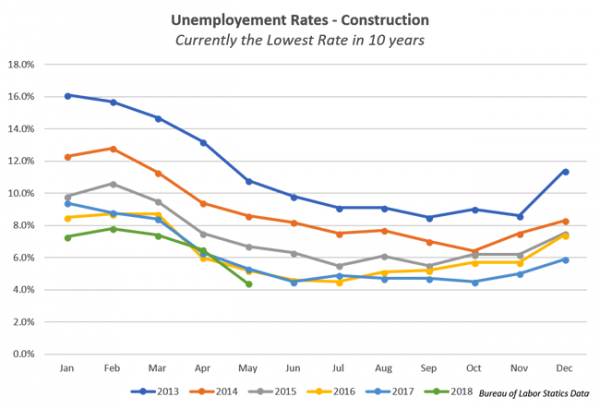
THE COMMERCIAL CONSTRUCTION CLIMATE
Currently, inside the construction industry, it is well-known fact that we have a labor shortage. This deficiency has heavily influenced two aspects of our business: hiring and costs.

The first challenge this deficiency presents is how and who we hire. We must add personnel to meet our commitments to our clients. So, the question that presents itself is: do companies hire people just to fill positions for the short-term, or do they hire team members with the intention of sustainability and growth?
I can’t speak for all companies, but here at The MDC Group, we take this hiring dichotomy very seriously. We do not bring on personnel with temporary employment being the objective. We believe that as our clients’ goals grow and change, so do the opportunities for full-time positions.
The current trend in hiring is to look for long-term candidates in their late 20s/early 30s so that the companies’ time and resources provide the greatest return on investment. However, we have found that the early Baby Boomer market is a widely untapped resource. We have hired superintendents out of or at retirement age and the results have been outstanding. When the culture lends to it, it can be a great learning experience for the whole team. Our seasoned veterans have enjoyed mentoring younger generations. A certain sense of accomplishment is achieved when passing on their hard-earned knowledge. There is plenty to be said for youth and vigor, but there is also no substitute for experience. Conversely, the younger generations have helped our veterans move into the new technological landscape. In the United States, the workforce is projected to be ~50% Millennials by 2020. I could easily turn this into a dissertation on this topic alone, but I won’t. The one comment I will make, however, is if you can’t relate to your client base, then they won’t continue to be YOUR client base.
The second challenge we have encountered is the increase in the cost of doing business. What a company could build a store for three years ago, looks nothing like it does now. I believe some clients think because the work is so plentiful, we are charging them an inflated rate. I, however, believe the reality is, we don’t have near the volume of tradesmen as the demand requires. Simply put, our kids don’t want to do what we did. They want jobs in technology inside of air-conditioning buildings. We, as companies, now must build in the overtime rates once our backlog is full. If there are not enough people, then the people we have must work more hours. Our subcontractor partners simply don’t have enough manpower because they are bidding and being awarded more jobs than they can perform.
For us, clients could help mitigate this labor shortage with lengthier notices of jobs in the pipeline, a minimum of two weeks for the subcontractor bidding process, fewer addendums to the blueprints and not scheduling a start date until all permits are in-hand. Some of these may not be possible every time, but we know that it would prove to benefit their profit margins. I think we forget slower can be faster. It is never faster to do it twice than to do it once, correctly.
Certainly, some of this is simply the nature of the construction industry over-all. It is not for the faint of heart. These labor shortages provide us with an opportunity for education of current/future generations as well as further engaging our clients, which in turn provides us better partnerships all-around.

